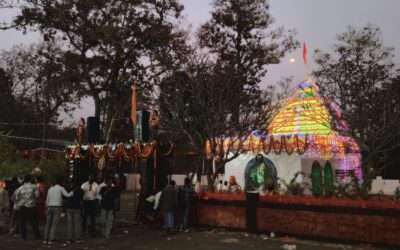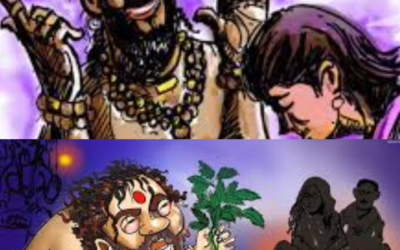Last 3 months in Chaitanya, my host organisation, have been the most enriching ever. With alternate months spent in Madhya Pradesh and Maharashtra, I have gotten the taste of both the preliminary stages of SHG (self-help group) formation and the functioning of established Federations i.e. the accumulation of all SHGs combined in an area. Now I have been asked to assist the team working on a different project, something that the organization hasn’t done before. A project that focuses not just on monthly savings and lending the money but where a large part of work would be to understand women weavers of Maheshwari sarees.
Maheshwar is a small and beautiful town in Khargone district of Madhya Pradesh, a 2-hour drive from Indore. According to mythical history, it has once been the abode of Lord Shastra Arjun and later, during the 18th century, served as the capital of Maratha kingdom under Devi Ahilya Bai Holkar. Situated on the banks of Narmada river, the fort is a symbol of unity among all communities living in the region. In recent past, a host of movies have been shot here such as Ashoka, BajiRao Mastani, Padman and Dabangg 3.
Apart from the historical significance, another imperative reason that makes this town attractive, are the handlooms that produce nine yards of hand-spun Maheshwari Sarees. These quintessential drapes of Maheshwar are one of India’s finest fabrics. According to a story here, the Queen Ahilyabai ordered the craftsmen of Surat and Malwa region to design sarees for her royal relatives and guests. The patterns found today are principally inspired by the motifs in the fort such as Chatai (Mat), Heera (Diamonds), Eent (Bricks), and Chameli ke phool (Flowers). These sarees were traditionally made of pure silk but with a passage of time and increase in demand, they started making it with pure cotton cloth as well, and some with a mix of silk and cotton. The weft of the sarees usually comprise of cotton threads while the warps are of silk. The intricate embroidery on borders is done with gold embellished Zari. One of the unique features of Maheshwari Sarees is its reversible border, which can be worn on both sides. It is locally known as Bugdi.

The colours used to dye Maheshwari yarns were, in earlier times, mostly vegetable dyes but now they’re replaced by chemical dying process. Traditionally, the sarees were chiefly dyed in darker shades, such as Maroon, Jaamla (Purple), Angoori (Grapes’ green), Rani (Deep Pink), Gul Bakshi (Magenta), Dhani (Green), Tapkeer (Deep Brown), and Aamrak (gold). The threads used to spun the sarees were made on traditional ‘Charkhas’ inspired by Mahatma Gandhi’s Khadi cloth.
The daily wage of a thread fabricator ranged between Rs. 10-15 or as per the reel they used to fill up whereas the wage of a person working on the looms ranged from Rs. 250-1200 per day paid according to the work done on sarees. The final pieces were further categorised by distinctive designs and patterns such as Chandrakala, the plain ones with simple borders and others Chandratara, Beli and Parbi with checked or striped designs. Pallu, the end of a saree is yet another unique element which is created with five stripes, having three colored and two white threads or patch work placed alternately.

With the passage of time, the traditional methods to spun have suffered a massive blow. The heavy wooden-pit looms that used to be fixed in the ground are now replaced by light-weight metal looms, which are easy to move around with less effort. Another major change is an increased usage of copper coated nylon threads instead of traditional Zari work as the former are cheaper as well as easily available in the market. The increase in import quantity of Chinese silk has also created havoc resulting in a demand deficit of sarees made from Mulberry and Tassar silk.
One of the major challenges of the weavers in Maheshwar is the influx of weavers from Lucknow in their area, who do the same work for handloom owners at a much cheaper rate than those by old professionals and permanent settlers of Maheshwar. This has created a tussle among the traditional and migrant weavers here.
Subsequently, the rising markets of other silk sarees such as Banaras, Kanchivaram and Chanderi are also giving a tough competition to the Maheshwari sarees. Therefore, to revive the work, various societies have started their initiatives in the region, one such being owned by the current prince Richard Holkar. The co-operative is popularly known as Rehwa (name of Narmada river in Maheshwar) Society which also runs a free school for children of weavers working in their society, and provides basic healthcare schemes for the welfare of their workers. Other popular societies in the region are Gudi Mudi and Tana Bana. My stay in Maheshwar has introduced me to such magnificent beauty of the historical town and royal Maheshwari sarees which were away from me until now.




Thank you so much for appreciating.. A comment always boast to write more and better blogs 😊
Sanra,good to read and reflect back and understand your perception